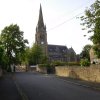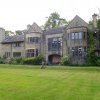They Designed Lightcliffe: 4 October 2017 John M Brooke
The population of the Hipperholme and Lightcliffe area grew considerably during the mid-Victorian period and with that growth came a number of fine public and private buildings. This increase was stimulated by the development of transport links especially the Leeds and Whitehall Road, now the A58, that opened in 1833. This was followed in 1850 by the Leeds and Manchester Railway, with stations at Hipperholme and at Lightcliffe.
These improvements encouraged mill owners and other business people to build fine properties and public buildings in the area. This, in turn, encouraged talented and well-known architects to work on the projects. Four practices, those of J. F. Walsh, Swinden Barber, Lawson and Lockwood, and William Ives, are worthy of note here. It was Joseph Frederick Walsh, though, who made the largest contribution to the area with a mixture of public and private buildings, whereas the latter three practices were responsible for the area's key places of worship: Hipperholme Methodist Church in 1870 (Ives), Lightcliffe Congregational Church (Lockwood and Mawson) in 1871 and St Matthew's Church in 1875 (Barber)
The area bears witness to a wide range of Walsh's work. He produced designs for fine private residences, a vicarage, workers' housing, public and educational buildings. His work also extended beyond the immediate area and included such structures as, to give but one example, Northowram Church. Within Hipperholme and Lightcliffe there are two fine private residences by Walsh: Craig Royston on Bramley Lane for Bradford stuff merchant Ward Andrews in 1897, and Longlands for Emma Watkinson in 1904. The Watkinson Bungalows, adjacent to the latter, are clearly also his work. These were erected as almshouses in 1926 and endowed by Emma Watkinson in memory of her parents.
A further, and delightful, example of Walsh's work is the former vicarage behind St Matthew's Church. This lovely property was built c1899 for the vicar and churchwardens. Much of the design appears to have been inspired by C F A Voysey a leading exponent of the Arts and Crafts movement.
At Hipperholme crossroads we find work by Walsh of a different nature. Here on George Street, he designed terraced housing for, it is generally accepted, workers at Brooke's brickworks and quarries, and at other local industries. Across the car park, and standing proudly on the main road, are the former Hipperholme Urban District Council offices that officially opened in 1899. The building now houses the public library. Walsh, in addition to receiving a commission for the work, won £10 in a competition to select the best design.
Walsh was born locally in 1861 and educated at Bradford Grammar School. In 1877 he was articled to his uncle Richard Horsfall with whom he worked on the headmaster's house at Hipperholme Grammar school. He died in 1950.


